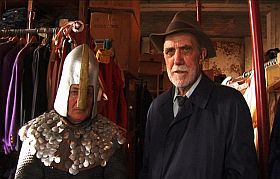


FILMCENTRALEN 1 /Ole John
Jeg har lyst til at dykke lidt ned i FILMCENTRALEN FOR ALLE, ned i repertoiret, finde ikke de film jeg har pligt til at se, men lige netop de film, jeg har lyst til at se streamet på min computer. Og lige netop med Filmcentralen lykkes det hver gang, uden problemer, uden forstyrrelser. Ligetil og enkelt. Det er smukt. Som den første vælger jeg Ole Johns Niels Bohr fra 1985. Det er fordi, Per Kirkeby engang skrev, at det bedste man kan gøre det er at læse videnskabshistorie. Jeg tror det var engang han skrev om Wegener og kontinenternes bevægelse. Det råd har jeg så fulgt siden, i hvert fald så længe, videnskabshistorie blev skrevet og filmet af poetiske forfattere og filminstruktører, af digtere og videnskabsmænd og -kvinder. Efterhånden som formidlere og journalister tog videnskabshistorien op blev jeg tøvende, det fangede mig mindre. Ole Johns film om Bohr har således holdt sig fast i min erindring i tredive år og den berører mig mærkeligt mere end forståeligt. Dengang den kom og så nu igen. Den holder, som vi siger.
Filmen har fortællerstemme, og som Iikka Vehkalahti så rigtigt gør opmærksom på: ”… I, for example, do not understand a person who, by principle, says: ’And I don’t use voice over’. It is like leaving out the music! What would such films as Citizen Kane, Sans Soleil or Sound Of Insects be without voice over?” Og som Vehkalahti er jeg derfor ikke modstander af voice-over, jeg er faktisk tilhænger af dette intime, fundamentale element, som betror mig, betror netop udvalgte mig historien. Og jeg kan godt lide fortællerstemmen i Niels Bohr, hører den som forfatterens, som Johns. Den rummer sin tids litterære tone. Det er det, jeg mærker, det er en fortrolighed, som at blive set som publikum.
Det næste jeg lægger mærke til, er en detalje, men ligeså vigtig for mig. De medvirkende får ikke navneskilt på, de er medvirkende, altså skuespillere i en film, og de er ikke vidner i en journalistik. Princippet svigtes dog sært nok ved scenerne med Erik Bohr og med Margareth Growing. Men det gør ikke noget, nu er jeg glad.
Det er især fordi, Ole John omgås arkivbillederne, både filmoptagelserne og fotografierne med interesse for deres egenværdi, deres skønheder som skabte billeder og deres stemninger af vemod, som gamle optagelser al tid rummer, og han bevarer denne aura selvfølgeligt og uden at understrege den og uden at distancere sig. Han overlader fotografierne til trickbordet og Hasse Christensens og Chris Kings nænsomme behandling, som nærmer dem til arkivfilmenes egetliv tilsvarende nænsomt tempokorrigeret, vil jeg tro. Arkivstoffet konverteres fra illustrationer til filmscener, som nænsomt klippes på plads. Og det er fordi, det er en filmisk dannelse bag, en dannelse, som hviler på på malerkunsten og på litteraturen, mere end på tv-fotografiet og avisteksterne.
Sådan er grundene til at jeg holder af den film, grundene til at den for mig holder, at jeg huske dens scener gennem tredive år, scenerne fra auditoriet i instituttet, et rum som hviler sig til næste dags forelæsere og tilhørere, scenen fra hotelværelset hvor Bohr nat efter nat forbereder følgende dags replik til Einstein, han er ude et øjeblik, servicet fra natmåltidet står der, udsigten til den sovende by er fyldt af øjeblikkets og stedets og erindringens intensitet og tøvende melankoli. Det var så stort, men det var.
Jeg bliver tiltalt i øjenhøjde, ikke belært, ikke omklamret, ikke forsøgt overtalt. Jeg får fortalt verdenshistorie og videnskabshistorie og en biografi i et klogt og tankevækkende filmessay så behersket og præcist klippet af Ghita Beckendorff og Niels Pagh Andersen, som velvidende, hvordan jeg er indrettet, hensynsfuldt bringer mig i godt selskab, og jeg mærker slet ikke, der er gået tre årtier siden sidst. Det er så rigtigt som noget, at Ole Johns Niels Bohr er blevet digitaliseret og gjort tilgængelig for publikum.
Danmark 1985. 60 min.
SYNOPSIS
Den danske videnskabsmand Niels Bohr var en af atomfysikkens største pionerer, og hans institut i København var i en årrække midtpunktet for udforskningen af atomets gåder. Filmen er historien om Borhs liv. Den er udarbejdet på grundlag af materiale dels fra Niels Bohr Institutets arkiv, dels fra arkiver verden over. I filmen indgår en række interviews med verdenskendte atomfysikere, som alle var nære venner med Bohr og medarbejdere i den periode, hvor København var centrum på dette område. Der fortælles om Bohrs ungdom, om den kritiske tid under krigen, om Bohr og atombomben og om hans berømte åbne brev til FN. En appel om samarbejde på tværs af alle grænser for at undgå flere katastrofer. (DFI filmdatabase)
CREDITS
Medvirkende: Victor Weisskoph, Carl F. von Weizsäcker, Friedrich Hund, Erik Bohr, Margaret Growing, John A. Wheeler, Rudolf Peleris. Manuskript og instruktion: Ole John. Instruktørassistent: Claus Bohm. Foto: Tom Elling, Dan Holmberg og Jenö Farkas. Musik: Ilja Bergh. Klip: Ghita Beckendorff og Niels Pagh Andersen. Produktion: Ole John Film.
FILMOGRAFI
Rejse i det indre univers, 1991. Den guddommelige vind, 1990. Snehvide, 1984. Gadeartister i New York, 1982. Ole John har sammen Jørgen Leth instrueret flere film, blandt andre Motion Picture, 1970 og mellem 1968 og 1971 lavet en række film i filmgruppen ABCinema (link til hans meget omfattende og vidtspændende filmografi)
Filmcentralen, streaming: http://filmcentralen.dk/alle/film/niels-bohr-0
Om Niels Bohr: http://www.dfi.dk/faktaomfilm/film/da/4660.aspx?id=4660
Om Ole John: http://www.dfi.dk/faktaomfilm/person/da/2843.aspx?id=2843
Litt.: Ole John, red.: Øjeblikkets foranderlige skønhed, ABCinema og filmoprøret i Danmark 1968-71, 2013. Lars Movin: Alt er i billedet, 2013, 169 ff.
